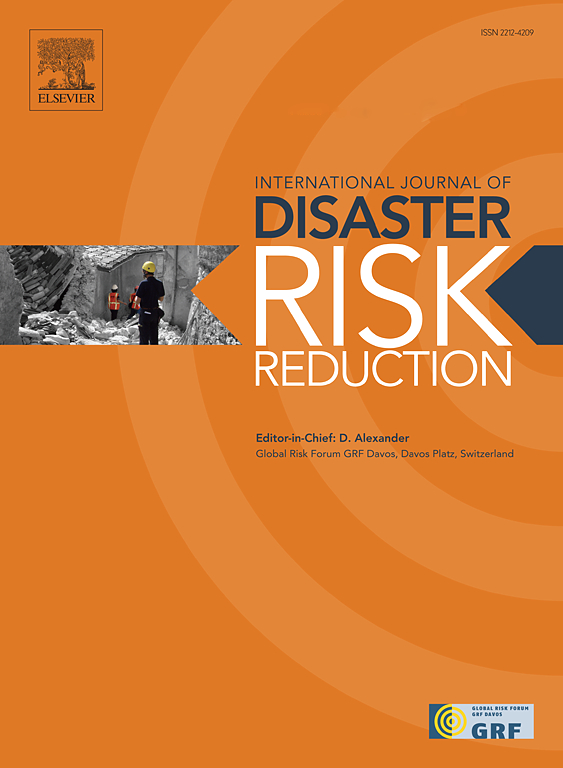亚齐减少灾害风险与适应气候变化相结合:印度洋海啸 20 年后的进展与挑战
IF 4.2
1区 地球科学
Q1 GEOSCIENCES, MULTIDISCIPLINARY
International journal of disaster risk reduction
Pub Date : 2024-10-15
DOI:10.1016/j.ijdrr.2024.104894
引用次数: 0
摘要
2004 年的印度洋海啸(IOT)造成印度尼西亚亚齐地区 16.8 万人丧生,约 50 万人流离失所的悲剧,使亚齐成为东南亚地质最不稳定的地区之一。不幸的是,2004 年的 IOT 还改变了一些地貌变化,特别是亚齐南部、西南部和西部沿海地区的土地下沉,使这些地区在过去 20 年中更容易遭受沿海洪水和淹没。2004 年的海啸引发的地震与水文气候灾害(需要减少地质灾害以外的风险)相辅相成,继续造成损失和破坏,损害了社区的福祉,并加剧了脆弱性。本文通过对利益相关者的深入访谈和文件审查,以首都班达亚齐为重点,探讨了亚齐在整合减少灾害风险(DRR)和适应气候变化(CCA)方面所取得的进展和面临的挑战。正如在印尼和东南亚其他地方观察到的那样,预计在实现《仙台框架》2030 年目标方面存在差距,研究结果提出了整合面临的各种关键挑战,包括:(1)分散的减灾和气候变化适应政策导致行动者之间在协调与合作方面存在差距;(2)在地方层面培养政治承诺仍是一项挑战;(3)缺乏财政能力和专项拨款阻碍了潜在的整合;(4)社区参与方面的不足延迟了适应和整合。本研究为政策见解和考虑提供了建议。本文章由计算机程序翻译,如有差异,请以英文原文为准。
Integration of disaster risk reductionand climate change adaptation in Aceh: Progress and challenges after 20 Years of Indian Ocean Tsunamis
The Indian Ocean Tsunami (IOT) of 2004, which tragically claimed 168,000 lives and displaced about half a million people in the Aceh region of Indonesia, established Aceh's reputation as one of the most geologically volatile areas in Southeast Asia. Unfortunately, the 2004 IOT also altered some geomorphological changes, particularly land subsidence in the coastal areas of South, Southwest, and West Aceh, making these regions more susceptible to coastal floods and inundation over the last 20 years. The 2004 tsunamigenic earthquakes had been compounded by hydroclimatic hazards (and required to reduce risk beyond geological disasters) that continued to cause loss and damage, compromise communities' well-being, and reproduce vulnerabilities. This article examines the progress and challenges for integrating disaster risk reduction (DRR) and climate change adaptation (CCA) in Aceh, with a focus on the capital city, Banda Aceh using in-depth stakeholder interviews and document reviews. Anticipating gaps in meeting Sendai Framework 2030 target, as also observed elsewhere in Indonesia and Southeast Asia, the findings suggest various key challenges for the integration, including (1) fragmented DRR and CCA policies leading shaped the gap in coordination and collaboration among actors; (2) nurturing political commitment remains a challenge at local level; (3) lack of fiscal capacity and lack of earmarked allocation hampers the potential integration; (4) and deficits in community participation delayed adaptation and integration. The study offers recommendations for policy insights and consideration.
求助全文
通过发布文献求助,成功后即可免费获取论文全文。
去求助
来源期刊

International journal of disaster risk reduction
GEOSCIENCES, MULTIDISCIPLINARYMETEOROLOGY-METEOROLOGY & ATMOSPHERIC SCIENCES
CiteScore
8.70
自引率
18.00%
发文量
688
审稿时长
79 days
期刊介绍:
The International Journal of Disaster Risk Reduction (IJDRR) is the journal for researchers, policymakers and practitioners across diverse disciplines: earth sciences and their implications; environmental sciences; engineering; urban studies; geography; and the social sciences. IJDRR publishes fundamental and applied research, critical reviews, policy papers and case studies with a particular focus on multi-disciplinary research that aims to reduce the impact of natural, technological, social and intentional disasters. IJDRR stimulates exchange of ideas and knowledge transfer on disaster research, mitigation, adaptation, prevention and risk reduction at all geographical scales: local, national and international.
Key topics:-
-multifaceted disaster and cascading disasters
-the development of disaster risk reduction strategies and techniques
-discussion and development of effective warning and educational systems for risk management at all levels
-disasters associated with climate change
-vulnerability analysis and vulnerability trends
-emerging risks
-resilience against disasters.
The journal particularly encourages papers that approach risk from a multi-disciplinary perspective.
 求助内容:
求助内容: 应助结果提醒方式:
应助结果提醒方式:


